INTRODUCTION
Body condition score (BCS) is a subjective assessment of body fat reserves in a dairy cow. It is now well established that the BCS at calving and the change in BCS after parturition are associated with productive, reproductive, and health performance in dairy cows [1]. However, relatively few studies have investigated the impact of BCS on performance in buffaloes. The calving BCS not only determines the transition success in dairy cows but also dictates the postpartum fat mobilization. As the buffaloes produce more fat in milk, it becomes even more important to assess the impact of calving BCS in dairy buffaloes.
The association between BCS and milk production has been extensively investigated [1,2]. Higher BCS (above 3.5) at calving has been shown to have negative impacts on dry matter intake (DMI) [3,4]. Cows with medium BCS (3.5) at calving are indicated as having optimal productive performance [1,5]. In a recent study, Zhao et al. [6] reported that cows with BCS (3.0–3.25) had the highest milk yield. A study in dairy buffaloes showed that that milk yield was higher for BCS of 3.5–3.9, followed by BCS of 4.0–4.5 and BCS of 3.0–3.5 [7]. It has been observed that cows calving with high BCS had elevated plasma non-esterified fatty acids (NEFA) concentrations [4,8]. High blood NEFA concentrations postpartum have been associated with impaired health and liver function [9]. High BCS at calving is associated with increased risk of metritis, retained placenta, dystocia [10], milk fever [11], and ketosis [12].
It has been hypothesized that in dairy buffaloes, the dynamics of fat reserves and their association with production and health would be different than that of dairy cows. The aim of the current study was to evaluate the association of body fat reserves at calving on post-calving productive performance and health in Nili Ravi buffaloes.
MATERIALS AND METHODS
The trial was conducted at Livestock Experiment Station, Chak Katora, Hasalpure, Pakistan (29°42’43.9”N 72°33’19.1”E; elevation = 139 m). Thirty-six (36) buffaloes were enrolled in the study approximately -40 days of expected calving and kept in a naturally ventilated shed with access to a loafing area. The dry cow feed consisted of total mixed ration (TMR) containing corn silage (60%), wheat straw (8%), and concentrate mix (32%; Table 1) on a dry matter (DM) basis to maintain the buffaloes’ respective BCS up to calving. The lactation diet consisted of lactation TMR with corn silage (40%), wheat straw (5%), and concentrate mix (55%; Table 1) on a DM basis. Diets were offered twice daily, in the morning and evening, according to farm protocols. Buffaloes received identical diets to allow ad libitum feed intake throughout the study (10% refusals). The manure from the shed was removed daily through scraping and washing. The animals were provided with water troughs for free access to fresh water.
The buffaloes were randomly divided into three study groups with an equal number of animals in each group (12 animals per group). The study groups were categorized according to their BCS (on a scale 1–5 with 0.25 increments) as follows: 1) low, buffaloes with BCS ≤ 3.0; 2) medium, buffaloes with BCS 3.25–3.5; and 3) high, buffaloes with BCS ≥ 3.75 at the time of enrollment. The concentrate allowance was given according to the requirements of each individual animal to maintain the BCS until calving. The animals were followed for 90 days post calving to monitor the transition success and early lactation. Data regarding parity at dry off (primiparous vs. multiparous), dry period length, gestation length, calving date, and calf sex were collected from the farm records.
Milk yield (kg) was recorded daily both at morning and afternoon milking. The collection of milk samples was done twice a week to assess the yield of the milk components. The fresh milk samples from morning and evening milking were collected for milk component analysis using a portable milk analyzer (Lactoscan Standard, Milkotronic, Nova Zagora, Bulgaria). The components included the percentages of fat, solids-not-fat, protein, and lactose. DMI was calculated on two consecutive days each week. A measured quantity of feed was offered, and the feed refusal was recorded by weighing the amount of feed left in the mangers after 24 hours. The DM content of the feed and the refusal were determined using a microwave oven with an average drying time of 8 minutes. Body weight (BW) and BCS were recorded weekly. The first post-calving BCS recording was done within three days after calving. The BCS was taken to be at a nadir when the lowest post-calving value was followed by two greater consecutive values; the same process was applied to determine the nadir of BW [5].
Disease diagnosis and treatment was performed by the farm veterinarian. All buffaloes were observed for milk fever, retained fetal membranes, and metritis from parturition to 21 d postpartum. Dystocia was observed at the time of calving and was dichotomized into no calving assistance or minor plus major assistance [13]. Retained placenta was defined as an animal failing to expel the fetal membranes within 24 h after calving. Metritis was characterized as a sick cow with a fever higher than 39.5°C and with a purulent or red-to-brown colored discharge from the vulva within 21 days of calving [14]. A case of milk fever was defined as a prostrated cow with minimal rumen contractions that responded to intravenous calcium treatment within 30 min. Buffaloes with decreased DMI and low milk production were tested for ketosis.
Blood samples were taken approximately three to five hours before morning feeding. The samples were collected at 21 and 7 days before expected calving and at 1, 7, and 21 days postpartum. For individual sampling, approximately 10 ml of blood was collected from the coccygeal vein in a plain red-top evacuated tube and handled according to the recommendations of Stokol and Nydam [15]. Plasma samples were analyzed for NEFA using a commercial kit (Randox Laboratories, Crumlin, UK).
All statistical analyses were performed using SAS 9.4 (SAS Institute, Cary, NC). A repeated-measures ANOVA was applied for milk yield, milk component yield, BW change, BCS change, DMI, NEFA, and energy balance (EBAL) using the MIXED procedure of SAS according to the following model:
where Yijk = the dependent variable; μ = the overall mean; Ti = the fixed effect of treatment i, where i = 1, 2, or 3, three calving BCS groups; Wj = the fixed effect of week j, where j = 1, 2,. . . or 12; Ti × Wj = interaction between treatment and week; Bk = the random effect of buffalo k, where k = 1. . . n; and eijk= the random error. First day milk production of individual buffaloes was used as a covariate in the model for the analysis of milk yield, milk components, and fat to protein ratio. The Least square means were separated using the PDIFF option with Tukey’s adjusted p-values. The differences were considered significant at p < 0.05 and a trend at a p value between 0.05 and 0.1.
RESULTS
BCS before calving was 2.88, 3.35, and 3.82 for the low-, medium-, and high-BCS groups, respectively (p < 0.001; Table 2). The differences in postpartum BCS were consistent with calving BCS classes (p < 0.001; Table 2), but the BCS change during the first 4 wk of lactation did not differ across the BCS groups (p < 0.2189; Table 3 and Fig. 1). The BCS decreased (p < 0.001) in all groups. The decrease was up to 2.4, 3 and 6 wk in the low-, medium-, and high-BCS groups, respectively. Buffaloes in the low-BCS group tended (p < 0.0689; Table 3) to reach the nadir BCS sooner than the buffaloes in the medium- and high-BCS groups. Interaction with time showed significant effect on BCS change among all the groups (p < 0.0161; Table 3).
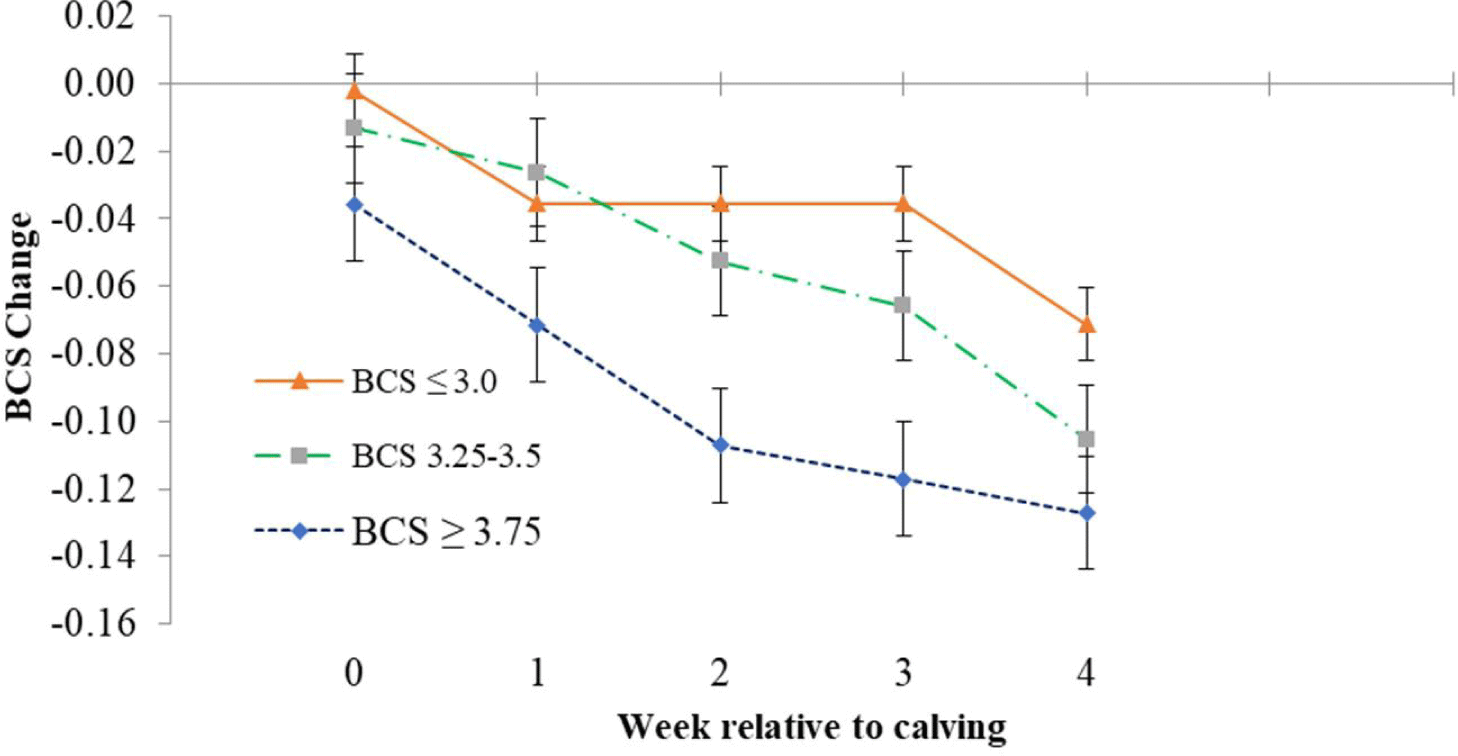
BW was highest for the high-BCS group throughout the study, but it did not differ between the medium- and low-BCS groups (Table 2). The differences in postpartum BW were consistent with calving BCS classes (Table 2), but the BW change during the first 4 wk of lactation did not differ across the BCS groups (Table 3). After calving, BW rapidly decreased (Fig. 2) in all groups. The decrease was up to 3 wk in the low- and up to 8 wk both in the medium- and high-BCS groups (Table 3). Buffaloes in the low-BCS group took fewer days to reach the BW nadir than the buffaloes in the medium- and high-BCS groups. Interaction with time showed non-significant effect on BW changes before and after calving (Table 3).
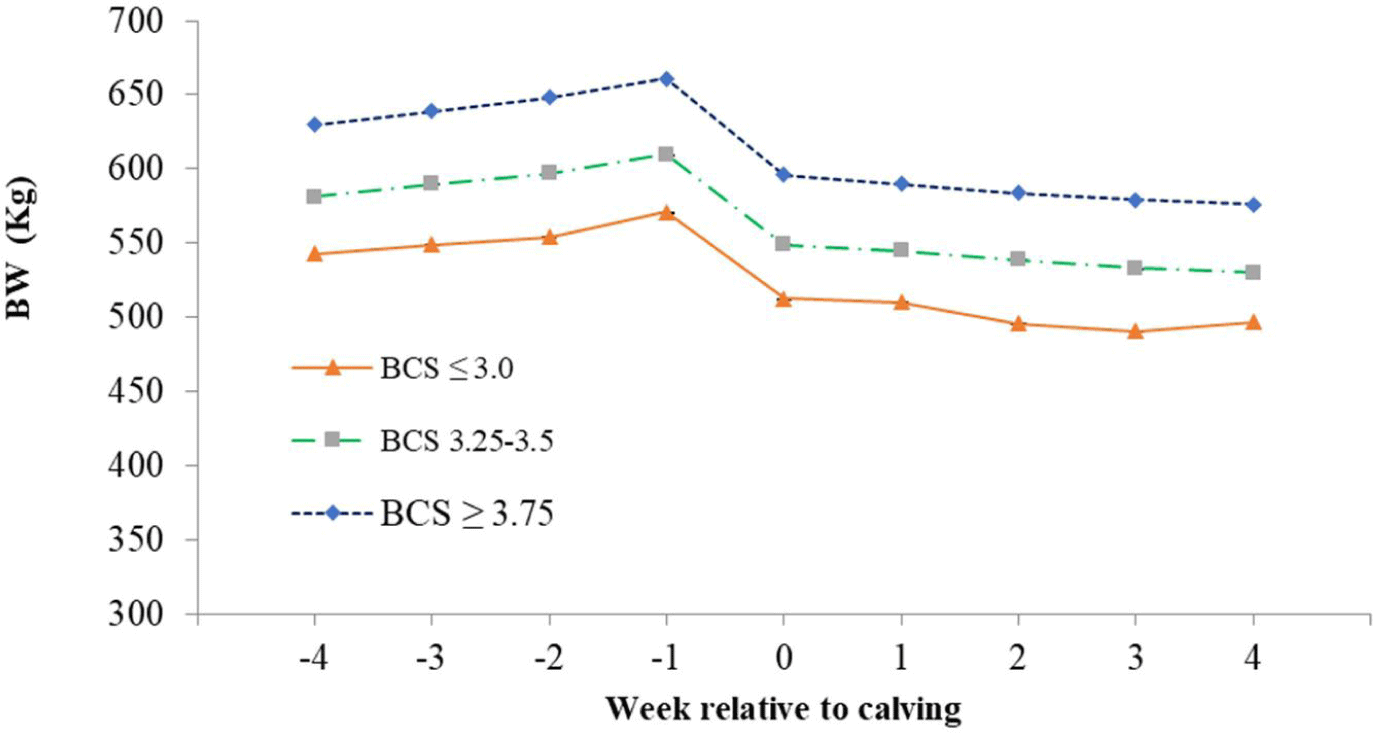
Overall, DMI decreased during the last 2 wk of gestation. The DMI decrease was numerically higher in the high-BCS group compared to the low- and medium-BCS groups (Fig. 3) but did not differ statistically (Table 2). DMI did not decrease in the low-BCS group before parturition (Fig. 3). Overall, DMI increased significantly during the first 4 wk postpartum and tended to be greater in the low-BCS group, averaging 16.3, 15.3, and 15.3 kg/d during the first 4 wk of lactation for the low-, medium-, and high-BCS groups, respectively (Table 2). Interaction with time showed significant effect on DMI before and after calving (Table 2).
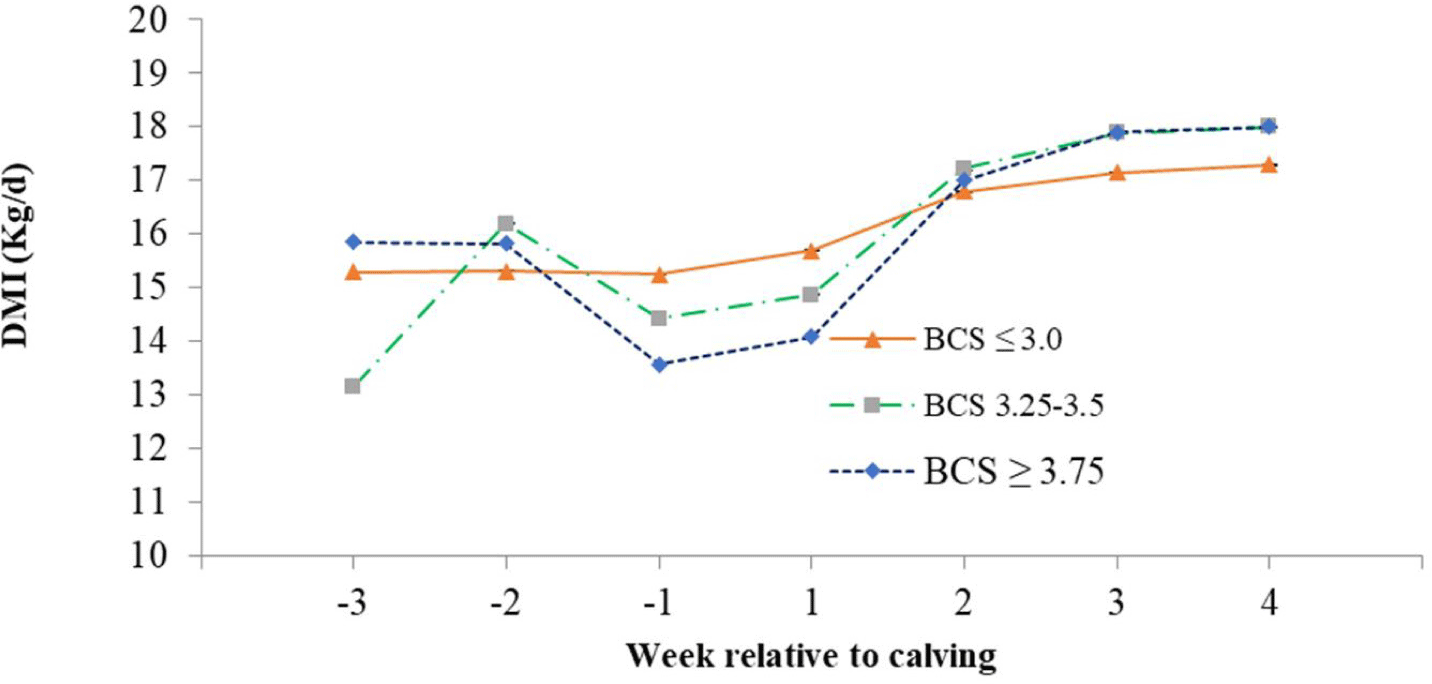
The average daily milk yield during the first 4 wk of lactation was 9.1, 9.6, and 9.7 kg/d for the low-, medium-, and high-BCS groups, respectively (Table 4), but did not differ statistically (p = 0.7158). Milk production increased significantly in all BCS groups during the first 4 wk postpartum (p < 0.0001; Table 4 and Fig. 4). Interaction with time had non-significant effects on milk yield (Table 4). The fat-corrected milk yield tended to differ across the BCS groups (Table 4), averaging 12.5, 14.6, and 14.4 kg/d for the low-, medium-, and high-BCS groups (p = 0.0753; Table 4), respectively. The milk fat yield was 505, 608, and 593 g/d for the low-, medium-, and high-BCS groups (p = 0.0653; Table 4), respectively. The milk protein yield was lowest for the low-BCS group (Table 4), averaging 354, 337, and 351 g/d for the low-, medium-, and high-BCS groups, respectively, but did not differ statistically. The milk lactose yield was 346, 329, and 336 g/d for the low-, medium-, and high-BCS groups, respectively, and did not differ statistically.
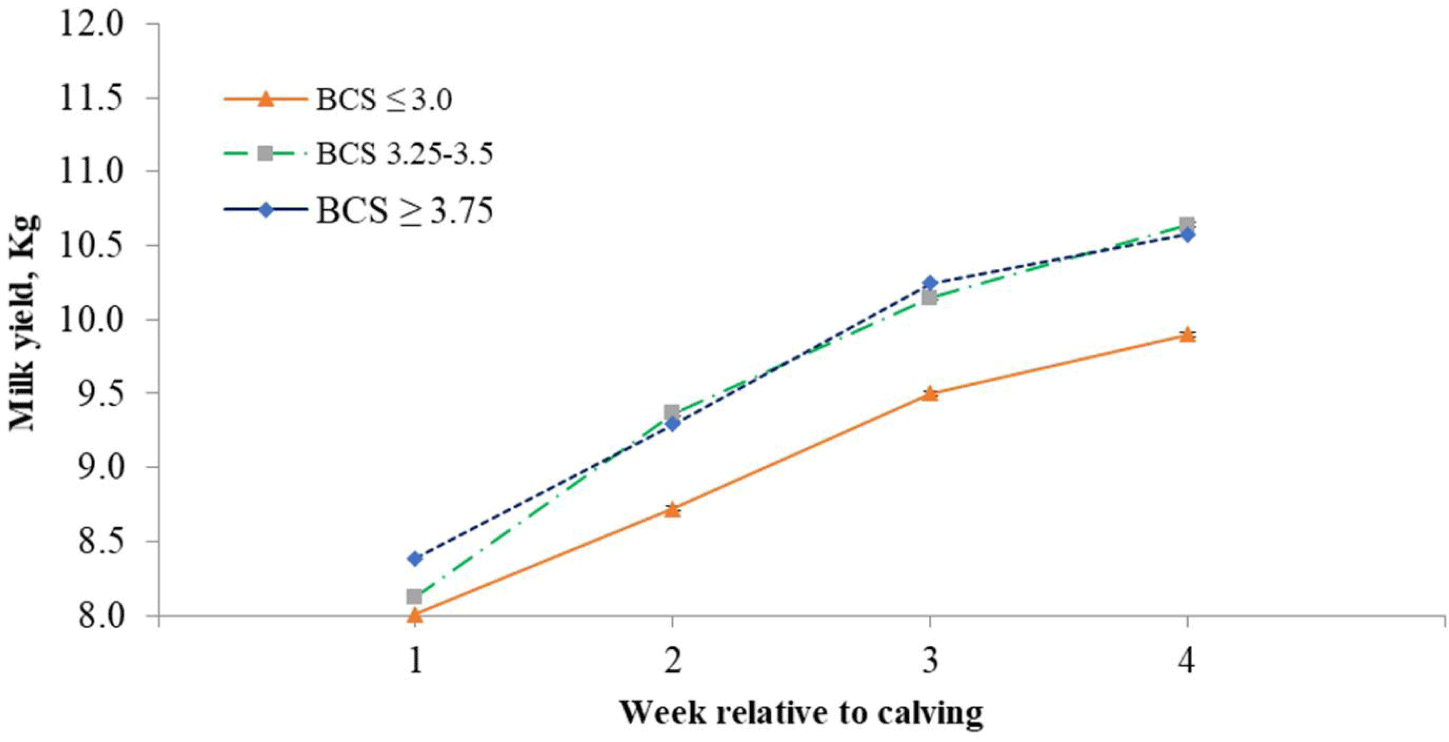
Postpartum EBAL was numerically high (p < 0.2904) for the low-BCS group and low for the medium- and high-BCS groups (Table 2 and Fig. 5), averaging 7.5, 5.2, and 5.8 M cal/d for the low-, medium-, and high-BCS groups, respectively (Table 2). Low BCS group remained in positive EBAL after parturition, and medium- and high-BCS groups reached positive EBAL by wk 2 postpartum (Fig. 5). Interaction with time showed non-significant effect on EBAL among all BCS groups (p < 0.1734; Table 2).
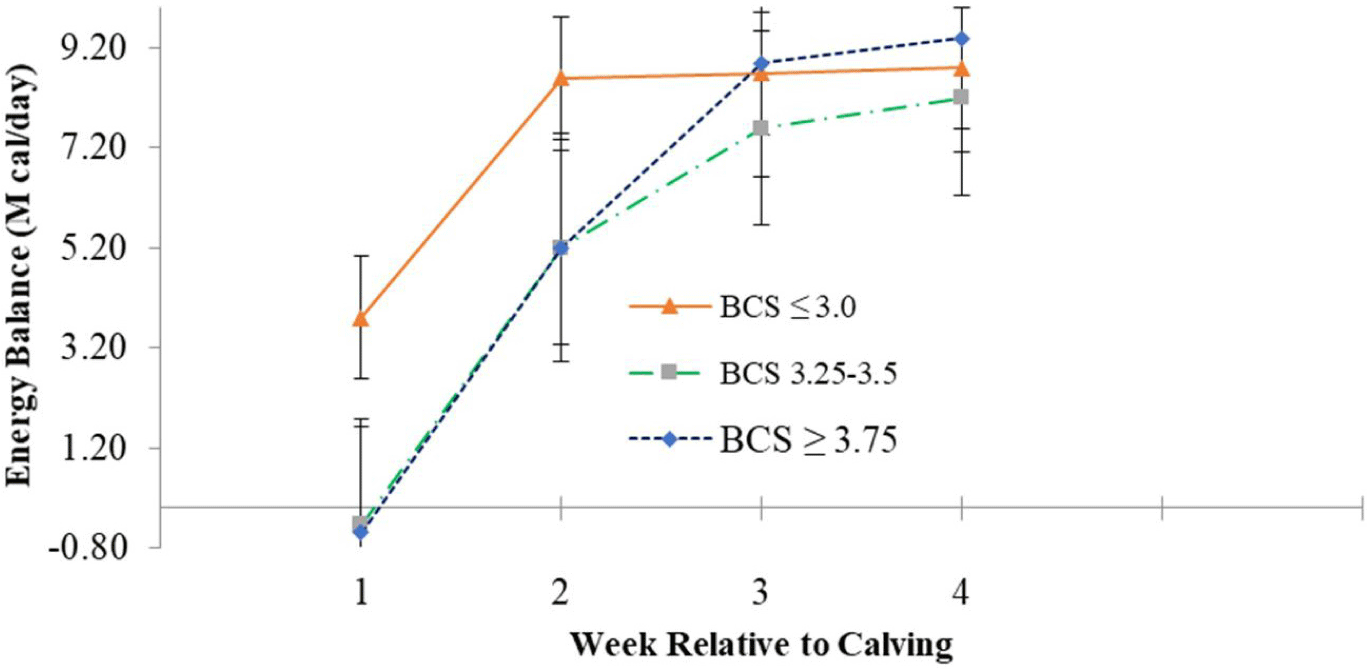
Plasma NEFA concentrations were highest for the high-BCS group, with significant increase during pre- and postpartum (p < 0.05; Table 2). Plasma NEFA concentrations were similar for the low- and medium-BCS groups before and after parturition (Fig. 6). Time had non-significant effect on plasma NEFA concentration before calving (p < 0.2388; Table 2) and significant effect after calving in all groups (Fig. 6). Interaction with time showed non-significant effect on NEFA concentrations among all BCS groups before and after parturition (Table 2).
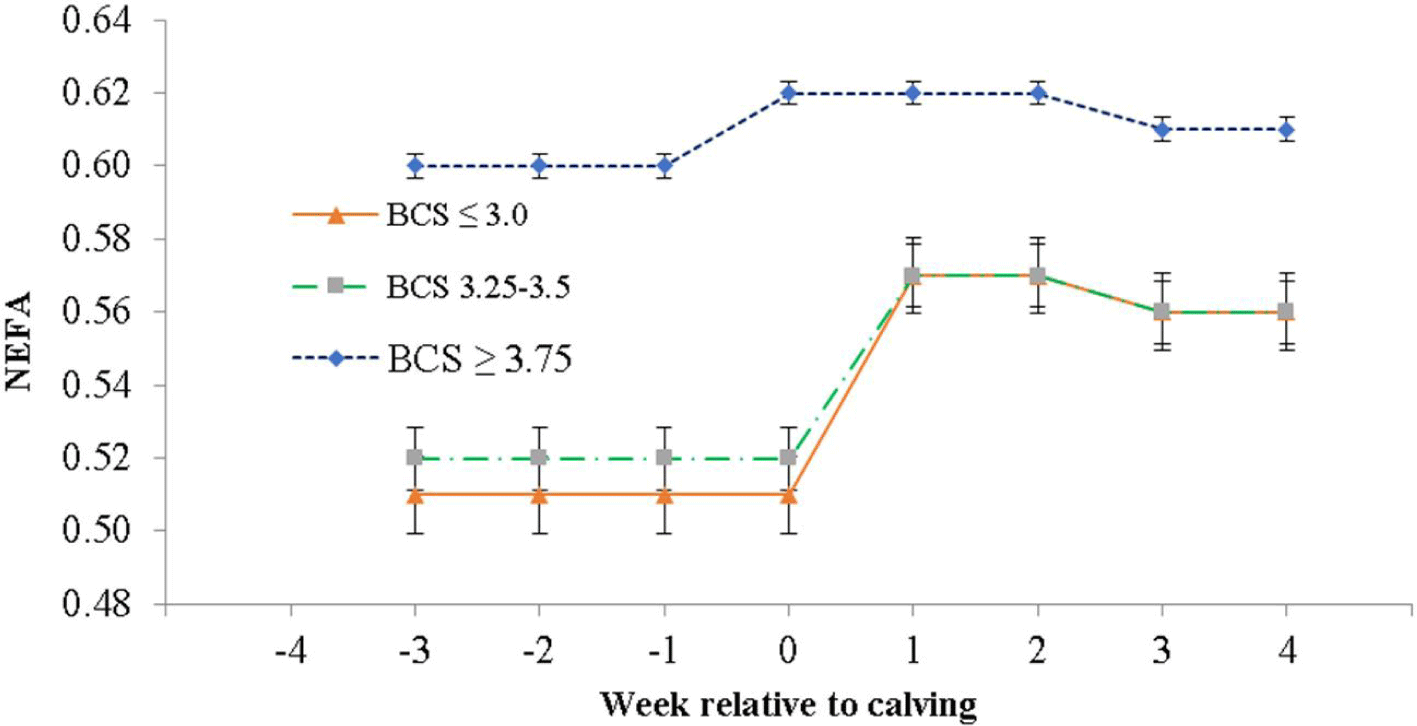
DISCUSSION
The postpartum BCS were consistent with calving BCS classes, but the BCS change during the first 7 wk of lactation did not differ across BCS groups. Despite the differences in calving BCS, postpartum BCS loss did not differ among the groups. It is possible that body condition scoring was not sensitive enough to detect minute differences in body reserve mobilization during early lactation. This may be due to low milk production, rapid increase in DMI after parturition, and the use of internal fat reserves. Our finding was consistent with Pires et al. [3], who also found that BCS changes during the first 7 wk of lactation did not differ across BCS groups. However, most of the literature showed a positive relationship between calving BCS and BCS loss postpartum [1,4,16]. Consistent with the current findings, Al Ibrahim et al. [17] found that cows with low BCS tended to reach the nadir BCS more quickly than the cows with high BCS.
BW was lowest for the low-BCS buffaloes; this may be due to differences in body size or body composition between buffaloes in the medium- and high-BCS groups, which were not measured. The BW loss among buffaloes in the high-BCS group was in keeping with previously reported findings in dairy cows [3]. Similarly, the low-BCS buffaloes reached the BW nadir sooner, as in dairy cows as reported by Weber et al. [18]. The decrease in DMI before parturition in buffaloes was similar to that in cows as reported earlier [3].
In the current study, the milk yield during the first 4 wk of lactation was only numerically different among the BCS groups, with lean buffaloes producing 0.5 kg/d less than the medium- and high-BCS groups. These findings were consistent with the findings of other researchers [4,19], who did not find any significant association between BCS and milk production. The literature shows a curvilinear relationship between BCS at calving and milk production [1,2]. Buffaloes with medium BCS at calving produced milk with greater fat content than lean cows, reflecting the availability of body fat in the former. Moreover, the use of estimated breeding value (EBV) of fat content as a covariate in the statistical model would have further explained the association of BCS with milk fat content as it is highly heritable trait. Lack of data on the EBV of fat content was a limitation of the present research. Further studies could address this limitation while investigating the association of BCS with production traits in dairy buffaloes.
In the present study, the low-BCS group remained in positive EBAL after parturition, and the medium- and high-BCS groups reached positive EBAL by 2 wk postpartum. Therefore, no cases of metabolic disorders with clinical signs were observed. Our findings were consistent with the study by Gillund et al. [20], who did not find any case of metabolic disorder clinically among BCS groups. The greatest plasma NEFA concentrations in buffaloes for the high-BCS group were in accordance with what has been reported in dairy cows [3,16,17].
The present study has provided experimental evidence that high-BCS buffaloes had more BCS and BW loss after calving. The buffaloes in the medium-BCS group appeared to perform better compared to the low- and the high-BCS groups with respect to milk fat% and blood NEFA concentration. More studies on high-producing buffaloes would further explore the association of calving BCS on productive and health performance.
